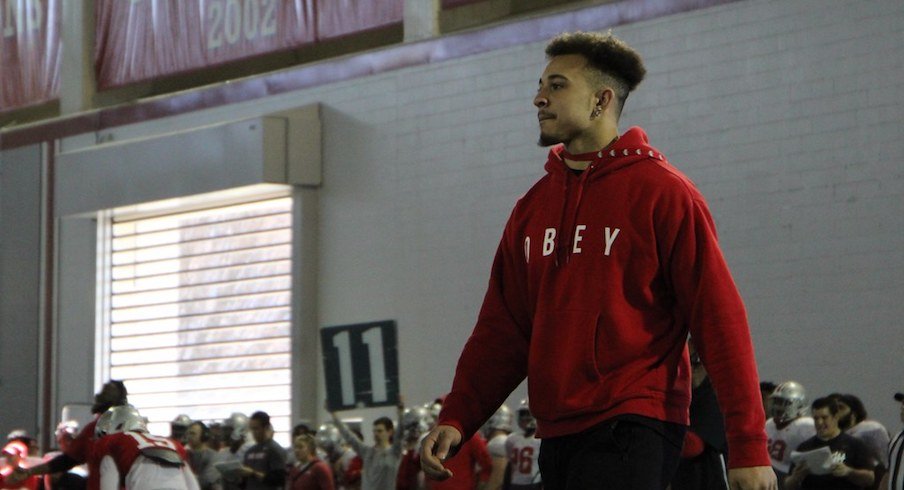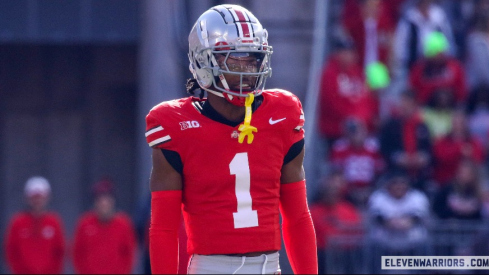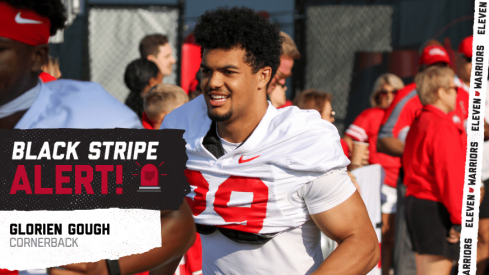History can help define the future, so we used Ohio State wide receiver history to put Julian Fleming's commitment into perspective.
When 2020 five-star wide receiver Julian Fleming committed to Ohio State on Friday morning, there were several reactions from not only fans but from current Ohio State players and commits, as well as past players. The one that seemed to stand out the most was Ohio State receiving legend and NFL Hall of Famer Chris Carter.
“Best news from the next great WR at #TheOhioState,” Carter tweeted.
Carter, who is fourth on Ohio State’s all-time receiving list, was clearly great in Columbus, but using history to navigate through some of the greatest receivers the program has seen and some of the receivers it’s put into the NFL, we tried to put into perspective what being the top wideout in the 2020 class or the third-highest ranked Ohio State commitment all-time could foreshadow for Fleming’s years as a Buckeye.
To get all angles into one scope, there would need to be different questions addressed, such as how Fleming compares to 2019 five-star receiver Garrett Wilson, how the last handful of top receivers have fared in their careers so far, what it means to be rated so high in 2020 versus pre-2000, how Fleming’s recruitment compares to record holders at Ohio State and all the way down to his wide receivers coach Brian Hartline.
Julian Fleming vs. Garrett Wilson
Ohio State has never brought in two five-star receivers in consecutive years until Friday, when Julian Fleming committed to the Buckeyes. The timing of the Texas-Pennsylvania pairing between Garrett Wilson and Fleming has placed a great deal of burden on their shoulders. They will be compared throughout their careers at Ohio State, and they are responsible for leading the next great Ohio State wide receivers after Parris Campbell, Terry McLaurin and Johnnie Dixon carried what Michael Thomas, Curtis Samuel and others laid down so well.
Wilson has gotten his fair share of media coverage during his first semester in Columbus. He arrived early and has shown that he can and will compete in the summer for a spot in the wide receiver rotation during his first season. He was the first five-star wide receiver to sign with Ohio State since Jalin Marshall signed in 2013, and no one would know how much time would pass until it’d land another.
It’s second might even surpass the first. While Wilson is rated as the 23rd-best commitment overall since 2000, Fleming is the third-best – 2021 Ohio State commit Jack Sawyer has not received a 247Sports Composite rating yet but is projected by 247Sports to be Ohio State’s second-best ever.
Looking at the new duo from a purely ratings-based stance, Fleming has the upper hand. Wilson was rated as a five-star prospect by 247Sports and Rivals.com but was labeled as a four-star recruit by ESPN. That could be a knock on Wilson’s size – 5-foot-11.5, 175 pounds – or a testament to Fleming’s team success – two state titles in two years. While most players sign as juniors, Wilson had just two full years under his belt on signing day, while Fleming has three. Everyone grows at different paces. Regardless, Fleming is given the edge.
In three years at Lake Travis High School in Austin, Texas, Wilson posted numbers similar to Fleming’s first three years. As a sophomore, junior and senior, he caught 219 passes – 96 as a junior – for 3,614 yards and 57 touchdowns. Fleming has caught 183 passes for 3,942 yards and 55 touchdowns before his senior year.
Both receivers will serve different roles within the Ohio State offense, which is only a positive for the Buckeyes.
The paths of the last five No. 1 wideouts
After being signed, every prospect has a different path. They fall into different systems with different coaches. Coaches leave or are forced to leave. Things can change quickly at the collegiate level, hence the transfer portal.
But this is how Fleming compares to the five No. 1 wideouts before him, which is an exercise that can temper some sky-high expectations out of the gate.
Garrett Wilson was the No. 2 wide receiver in his class to Georgia receiver Jadon Haselwood. Haselwood signed with Oklahoma and actually has similar measurements – 6-foot-2.5, 196 pounds – to Fleming. Oklahoma actually accomplished a rare feat and signed two five-star receivers in Haselwood and No. 3 wideout Theo Wease, who are both expected to have a big impact in Jalen Hurts’ season at Oklahoma.
Justin Shorter was the No. 1 wide receiver and the No. 8 overall prospect in the 2018 class. He will be a major impact player as he grows, but as a freshman he caught three passes for 20 yards and ran the ball once for nine yards. He’s a big-bodied wideout, at 6-foot-4, 226 pounds, and will play a similar role to Fleming at Penn State in a bit of a packed receivers room.
Surely, Ohio State fans know the No. 1 wide receiver in the Class of 2017 went to Michigan. Donovan Peoples-Jones has played in every game since the beginning of his college career in Ann Arbor but has yet to have his breakout year. He was rated as the No. 12 player overall in his class, and now, entering his junior year, he has compiled 69 catches, 889 yards and eight touchdowns, all of the touchdowns coming in his sophomore year.
The 2016 No. 1 wide receiver, Demetris Robertson, has had a rough road at the college level. He signed with Cal and made an immediate difference as a freshman, catching 50 passes for 767 yards and seven touchdowns, but he only played two games as a sophomore because of what has been reported as family concerns at home. He transferred to Georgia, in his home state, where he could be close to family and received immediate eligibility but played in just four games and caught no passes for the Bulldogs.
Alabama’s Calvin Ridley was the No. 1 wide receiver in 2015 and represents the best-case scenario for Fleming’s future as 2020’s No. 1 wideout. Ridley played every game of the three seasons he was at Alabama, and his most productive year was his freshman year, when he caught 89 passes for 1,045 yards and seven touchdowns. Alabama won the National Championship in his junior season, and he was drafted by the Atlanta Falcons, where he made 64 catches for 821 yards and 10 touchdowns during his rookie season in 2018.
What it means to be rated
When a player is mentioned in the same breath as former Buckeyes like Terrelle Pryor and Ted Ginn Jr., the two signees ahead of Fleming in the all-time highest-rated prospects category, it can lead to great expectations. Ginn remains one of the fastest players in the NFL, and Pryor is one of the biggest spot playmakers. Both had great careers at Ohio State after being the No. 2 players in their respective classes – Ginn in 2004 and Pryor in 2008.
Unfortunately, neither player had been able to find a competent NFL staff that knew how to use their skillsets. That is until Ginn landed in New Orleans at the age of 32. That begs the question of what it means to be rated in modern high school football.
Ginn and Pryor were two of the most athletic players college football has seen in the 21st Century, and their ratings were created when ratings systems were beginning to find traction around the country. Still, HUDL.com and MaxPreps.com were hardly around at all yet. Social media certainly wasn’t a thought yet, as Pryor signed with Ohio State a half-year after the first iPhone was released.
So what parallel is drawn between the rating systems and recruiting landscape of the mid-2000s and the oversaturated recruiting processes of the late-2010s? All three players had and have potential going into college.
In the days when accolades were how a name was recognized nationally, Ginn was named USA Today’s Defensive Player of the Year. He intercepted eight passes during his senior year and returned five of them for touchdowns. He signed with Ohio State as a cornerback and has played 12 years in the NFL as a wide receiver.
Pryor initially committed to play basketball at Pittsburgh before eventually choosing to play football at Ohio State. He was a phenomenon, as he rushed and passed for more than 4,000 yards each. He was named a Parade All-American in both basketball and football and had many more accolades to go with that. He eventually grew into a prototypical-type quarterback with the option to run at Ohio State, throwing for 2,772 yards with a 65-percent completion rate and running for more than 600 yards in each of his three seasons.
As ratings begin to inflate, though, some of the highest-rated prospects of the 2000s are beginning to drop out of the all-time lists. Of the top-50 recruits to commit to Ohio State since 2000, 19 of them are either on the roster today, have college eligibility remaining or are committed to play for Ohio State. Ohio State has had some great recruiting classes in recent years, but with recruits like Fleming, Paris Johnson Jr. and Jack Sawyer – who have not yet played collegiate ball – listed above former Buckeye running back Beanie Wells shows that the rating system is purely a measure of potential and not a guarantee for production on the field.
The Brian Hartline Connection
Taking that potential and turning it into production has much to do with the coaching staff around a prospect, and Ohio State wide receivers coach Brian Hartline is quickly becoming the best in the country at his job.
A lot of the comradery that was felt between the three receivers that entered the NFL Draft in April – Campbell, McLaurin and Dixon – was not only because of the receivers as people but also because of Hartline’s energy at the coaching position. That is a large part of what attracts 2020 and 2021 recruits to him and was certainly involved with Fleming’s commitment.
The Room: Wide Receivers
— Ohio State Football (@OhioStateFB) April 10, 2019
There's one thing that @brianhartline preaches: Be Different.#Zone6 is doing just that, relying on accountability, empowerment, and leadership to continue to redefine the wide receiver position. #GoBucks #BeDifferent pic.twitter.com/rDktaxzAqg
Hartline has proven that he can get to a productive level in college and in the NFL, where he spent seven seasons.
Fleming and Hartline have a lot in common when it comes to their recruitments. Hartline was also a track star at GlenOak High School in Canton, but he didn’t receive nearly the attention in 2005 that Fleming is in 2020. The difference is that Hartline once grew up a couple hours away from Ohio State, like Fleming did with Penn State, though Fleming chose to go away from home despite his emphasis on family. The understanding of home and family is a good connection to create, and that clearly provided some leverage for the two to develop a relationship and for Hartline to understand what it would take for Fleming to want to be a Buckeye.
Now, Hartline can work with the top wide receiver talent in the class and develop Fleming into a more polished version of himself.
If there is a best-case scenario for a wide receivers coach, Fleming found his in Hartline.
How Fleming compares to the OSU greats
Julian Fleming is familiar with breaking records. By the end of his high school career, he will have rewritten Southern Columbia’s record book and will likely hit the 5,000-yard mark. With another season to go, he owns statistical totals that many of the best wideouts in the typical recruiting classes don’t see.
If a football player could be considered a “five tool” guy, Fleming would own that title. He has size at 6-foot-2, 200 pounds, speed to win the state silver medal twice in track and field and the strength and body control to play on the sidelines and in the middle of the field.
That sounds a lot like Chris Carter. The former Ohio State great was 6-foot-3 and just a hair above 200 pounds with many of the same skills as Fleming offers coming to Columbus. Both played basketball in high school as well, though Carter was good enough to consider playing both football and basketball until he became too significant to the football team to dedicate the time.
Fleming also compares similarly to David Boston, though Boston had much more size to his body at 6-foot-2, 230 pounds. Boston’s record for most catches in a career (191) is in jeopardy this season, as K.J. Hill (144) closes in.
Fleming doesn’t quite have the speed of some of the most dynamic receivers to come through Ohio State, such as Joey Galloway, Curtis Samuel, Terry Glenn, Corey Brown, Santonio Holmes, Parris Campbell, Terry McLaurin, Michael Jenkins or Ted Ginn, but he has many tools from each of their skillsets in one package, much like Carter had in the 80s.
Until Fleming makes catches like this, though, that comparison will need to wait.
In 247Sports’ player comparison, he is compared to former Ohio State wideout and current New Orleans Saint Michael Thomas, who is working his way into the top-five receivers in the NFL. Thomas led the league with 125 catches in 2018, and his combination of size – 6-foot-3, 215 pounds – and speed and his ability to play inside, outside, deep or shallow can also be seen in Fleming’s tape.
In two full seasons at Ohio State, Thomas caught 110 passes for 1,580 yards and 18 touchdowns.


